Among the ornamental shrubs, spirea occupies a special place. She is surprisingly unpretentious and easily forgives the gardener even the most unobtrusive care. A wide variety of forms and species allows you to choose the plant that best fits into the surrounding landscape to decorate the site. Planting and caring for spirea is not difficult, even a novice gardener will cope with this.
Material Content:
Spirea: types and varieties
The genus Spirea belongs to the pink family and is quite numerous, it includes more than 70 species. The distribution area of this deciduous shrub is wide. It can be found in the northern hemisphere in most climatic zones. Spiraea rarely has solitary flowers, most often they are collected in a corymbose inflorescence, sometimes in a panicle. Coloring of flowers depends on the flowering time of the species. Plants blooming in spring have white flowers that bloom on last year's shoots, pink-raspberry gamma prevails in species blooming in summer, flowers are located on annual growths.
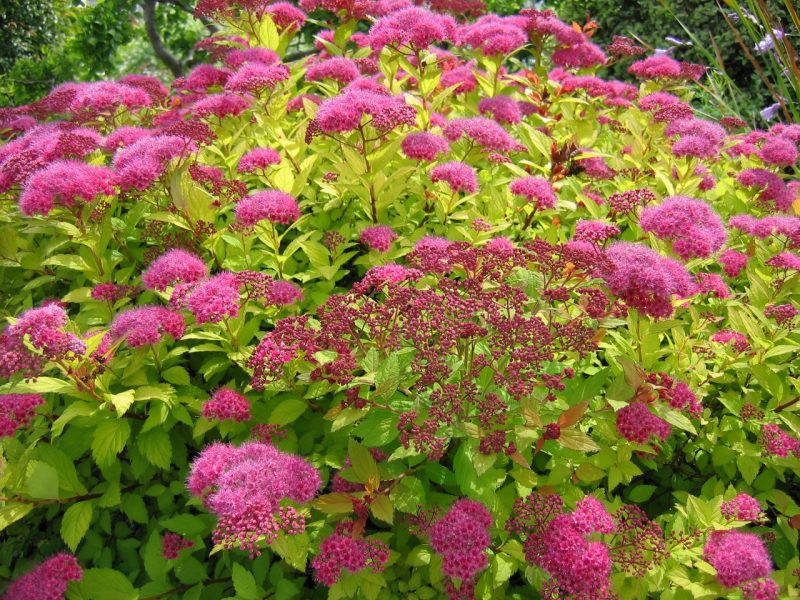
The most common species.
- Middle Spirea is an inhabitant of Siberian and Far Eastern forests, a tall shrub is higher than 2 m with white corymbose flowers that open in May and do not fall for 3 weeks, are resistant to frost and drought tolerant, used in landscaping, suitable for northern regions.
- Birch leaf spirea - grows in Siberia, from 1 to 2 m high, white flowers are gathered in huge flaps - up to 10 cm in diameter, blooms in late May and blooms all June.
- Urban spirea - has been used in landscaping for 200 years, there are cultivated hybrid varieties. In nature, a low, up to 1 m shrub, blooming in late May. Quite large flowers are collected in corymbose inflorescences, due to the large number of long yellow stamens, it seems that they have a golden hue. This type of spirea is drought-resistant and frost-hardy, can be used to strengthen floating soil.
- St. John's wort - spruce up to 1 m high, flowering - May-June, white flowers, used to obtain new plant forms.
- Gray spirea is the result of crossing the previous species and whitish-gray spirea, has highly decorative varieties that bloom in spring. The florists' favorite variety of this species is Spiraea Grefshame. The shoots of a tall shrub bend toward the ground under the weight of the flowers that completely cover the bush. Flowering is so plentiful that the leaves are almost invisible.
- Spiraea oak-leaved - blooms with umbrella-shaped inflorescences of white flowers with a large number of protruding stamens for 25 days, flowering occurs in May-June. The species is used in culture, tolerates a haircut.
- Nippon spirea came to us from Japan - this highly ornamental shrub 1-2 m high is decorated with yellowish-white shields of inflorescences that appear in June. It does not differ in frost resistance, in severe winters the tops of shoots freeze, but quickly recover. The most famous variety is Snowound. A huge number of flowers on a bush up to 1.5 m high makes it very decorative at the time of flowering. The width of the bush is 2 times the height.
- Wangutta spirea is no less decorative - a hybrid species that blooms very abundantly in June-July with white flowers gathered in shields. The bush is of medium height and can freeze in frosty winters.
- Japanese Spirea is quite thermophilic, but thanks to the low height of the bush - up to 1 m winter without loss, sheltered by snow. The most interesting varieties: Little princesses and Shirobana. Little princesses - a bush up to 80 cm high and 1.2 m wide blooms very abundantly in June-July, pink flowers collected in medium-sized shields, grows slowly. Shirobana - bush up to 0.8 m high and 0.6 m wide, blooms in mid-summer. Flowers in corymbose inflorescences have three colors - white, pink and raspberry, if you trim the faded inflorescences, new ones will adorn the bush for another month.
- The lovely spirea stands out among other species by double flowering: in June on last year's shoots and in July and August on newly overgrown. Flowers are collected in complex guards, can be white or pale pink. The view does not differ in frost resistance - up to -18 degrees, therefore it hibernates in the middle lane under cover.
- Bumald's Spirea is a decorative hybrid species, and has a yellow-leaved shape. The bush is low - up to 0.8 m in width and height. Blooms for more than 3 months with bright pink flowers in large guards. The most famous variety is Anthony Vaterrer.
- Loosestrifera spiraea in the wild grows in Siberia. The tall bush blooms in July and August with bright pink flowers collected in pyramidal panicles.
- Douglas spirea grows above 2 m. In the second half of summer, it is decorated with pink flowers collected in panicled inflorescence.
- When crossing the previous species and loosestrife, they received billiard spirea. A high frost-resistant shrub blooms in the second half of summer and is decorated with large panicled pink blossoms until the frosts.
- Hybrid lilac-colored hybrid spirea also blooms for a long time, only panicle inflorescences have a lilac-pink color in accordance with the name. The bush can grow up to 2 m.
Spirea: features of cultivation
Spirea is unpretentious, but with proper careful care give abundant flowering. Different flowering periods dictate different pruning times. Some species and varieties have their own particular preferences regarding soil and care.Most spires prefer humus-rich, but not heavy soil without stagnant water, but they will feel good on not very fertile soil. So that the roots do not get wet, they need drainage. But before planting a plant, it must be propagated.
Bush propagation
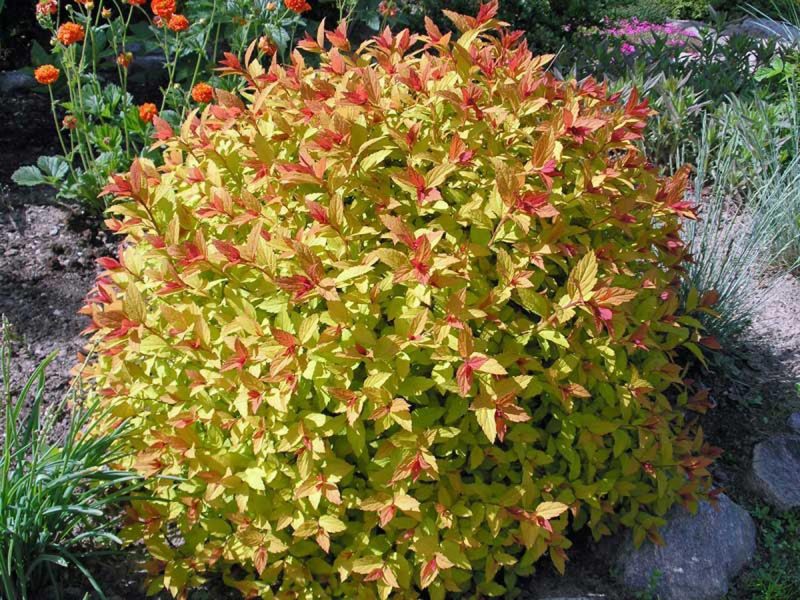
Propagating spirea is very easy. Some species give root shoots that can be planted. Parts of the divided bush take root well. Flexible shoots allow you to root layering. For propagation of all species, cuttings can be used, and for non-hybrid forms and varieties, seeds can also be sown.
Cuttings
When rooting the cuttings, an exact copy of the parent plant will be obtained. Green cuttings in early flowering varieties are cut at the beginning of June, and in late flowering varieties at the end of the month. For already lignified cuttings, the best rooting time is autumn, September or October.
- The annual green shoot is cut and cut into pieces with 5-6 leaves.
- The bottom pair of leaves is removed, the rest are cut in half.
- Put the lower section into the vessel with the epin solution for 12 hours.
- It is treated with a powdery root formation stimulator.
- Planted in a container with loose soil, sprinkled with a layer of sand at an angle of about 40 degrees, to stimulate root formation.
- Cover with a film or a glass jar and put in a lace shadow under the trees.
- Moisturize the soil in the cuticle, preventing it from drying out, and the cuttings themselves are sprayed several times a day.
- In the fall, a container is instilled into the soil, mulched with fallen leaves and covered with a wooden box.
- In the spring, shelter is removed. After the emergence of young shoots, plants are planted in a garden in a permanent place.
Seed propagation
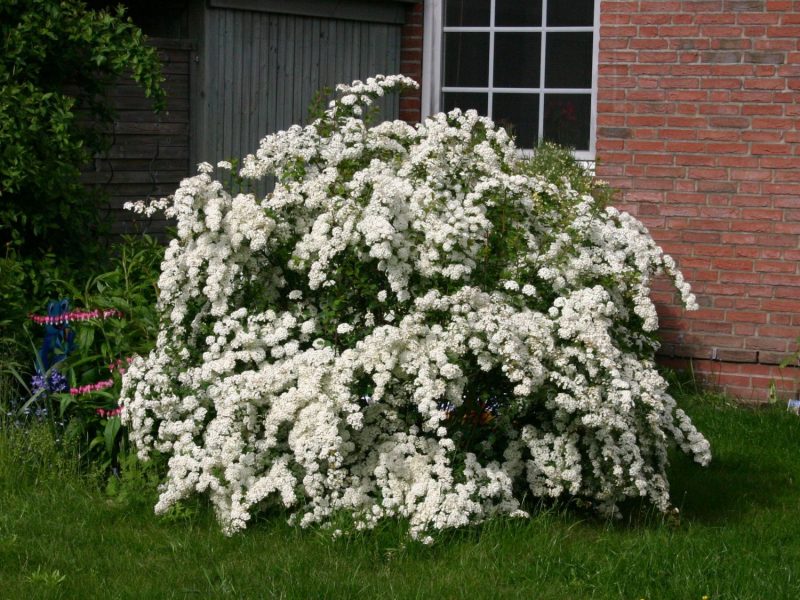
In non-hybrid varieties and species, seed germination reaches 80%. Collect them when the boxes turn brown, but have not yet opened. They are dosed in the room for 2 weeks. You can sow both in winter and in spring. Seeds of stratification do not require. Seedlings dive when 2 true leaves are formed. Further care: watering as needed, 2 top dressing with full mineral fertilizer. In autumn, seedlings are planted in seedlings, and next year in a permanent place. They begin to bloom for 3 years.
Outdoor landing
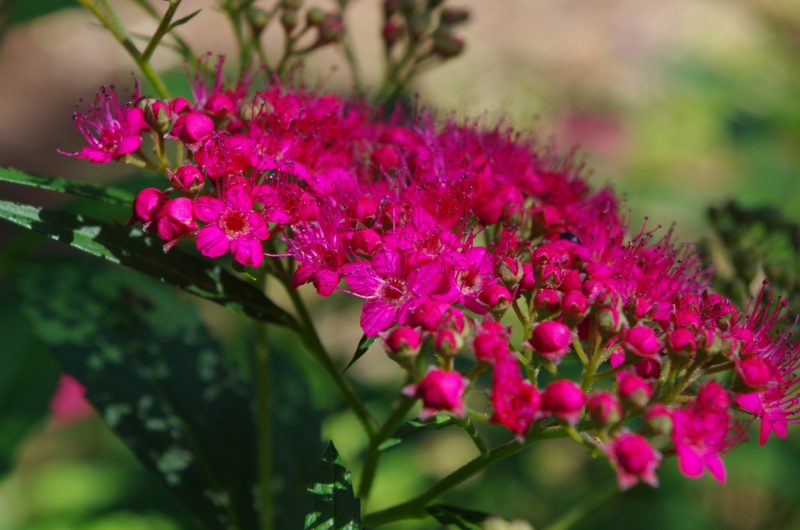
Proper planting is the key to abundant flowering and plant health. It is very important to maintain the optimal distance between plants in order to provide them with the necessary nutritional area. When laying a hedge, it is enough to plant spirea 30 cm from each other, for a normal planting, the distance should be greater, as the bushes grow very wide: for tall varieties - about 1 m, for low-growing - 0.8 m.
Selection of planting material
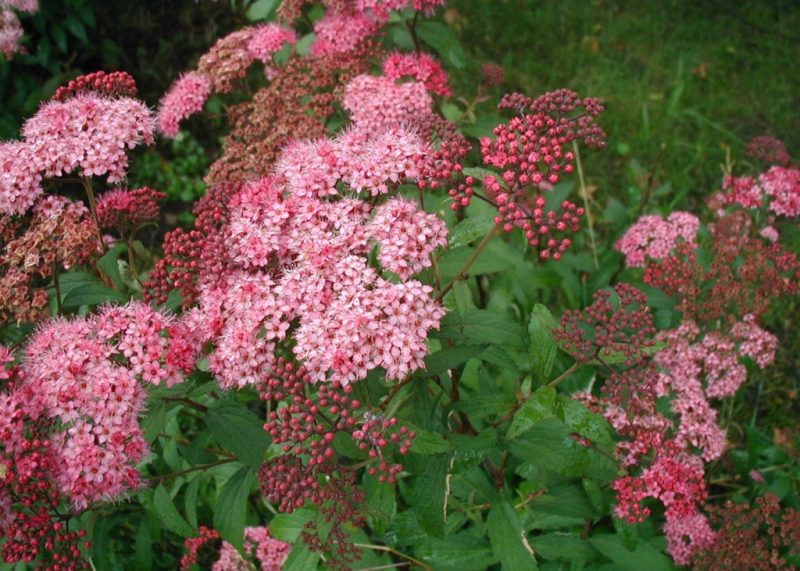
Now there are many varieties and hybrids of spirea on sale. The choice of a plant depends, first of all, on what place spirea will occupy in the landscape design of a particular site. A hedge will require many plants of the same species, it is better if they are tall. As a tapeworm, you can plant an openwork bush with long flowering. On an alpine hill, undersized compact varieties will be appropriate. But no matter what variety you choose, the plant should have a developed and healthy root system, consisting of 3 core roots and a well-developed lobe covered with clay mash. In the spring planting, not swollen buds, but in the autumn, already swollen leaves. It is best to choose a seedling grown in a container - it can be planted throughout the growing season.
How and when to plant?
Spirea is planted in pre-dug pits. Their size should be slightly larger than the root system of the plant. Typically, the depth is about 70 cm, 20 of which account for drainage made of expanded clay or brick fragments. The diameter of the pit is determined by the size of the roots.
Landing algorithm:
- a plant is set on a mound of earth poured in a pit, spreading its roots;
- they fill up the earth, taking into account that the root neck is strictly at the level of the soil;
- watered in a landing circle, using from 2 to 3 buckets of water;
- mulch the soil around the bush with a peat layer 7 cm thick.
Planting time depends on the selected variety: late flowering plants are planted in spring, early flowering plants are planted in autumn, but no later than 3-4 weeks before frost.
Soil preparation and location
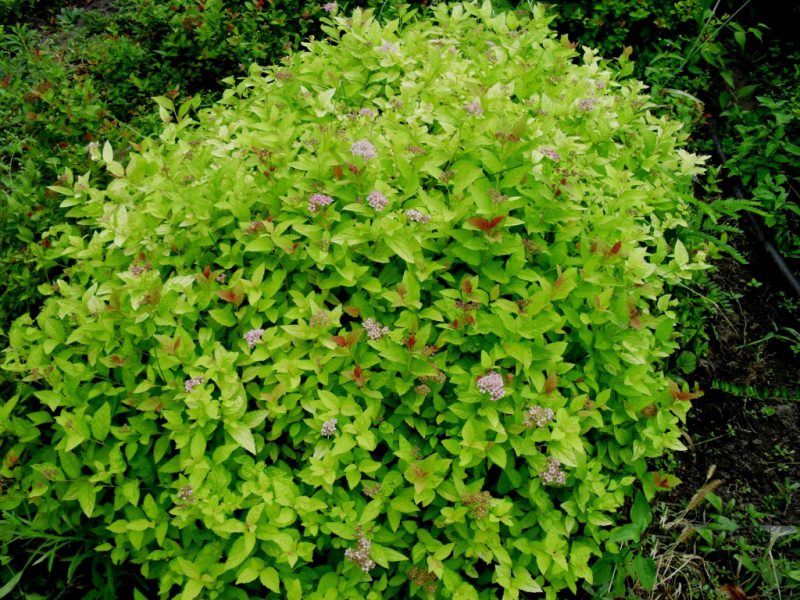
The landing site should be well lit by the sun, slight shading during the day is allowed. It must be remembered that in the shadow of the spirea blooms poorly.
This plant is undemanding to the soil. The preferred primer for spirea is light turf or leaf, with a neutral or slightly acidic soil reaction. Heavy clay soils are improved by adding sand and peat, a little clay should be added to light sandy soils. Of fertilizers, you can add Art. long-acting fertilizer spoons ABA for each bush. This amount is enough for the plant for several years.
The nuances of planting in spring, autumn
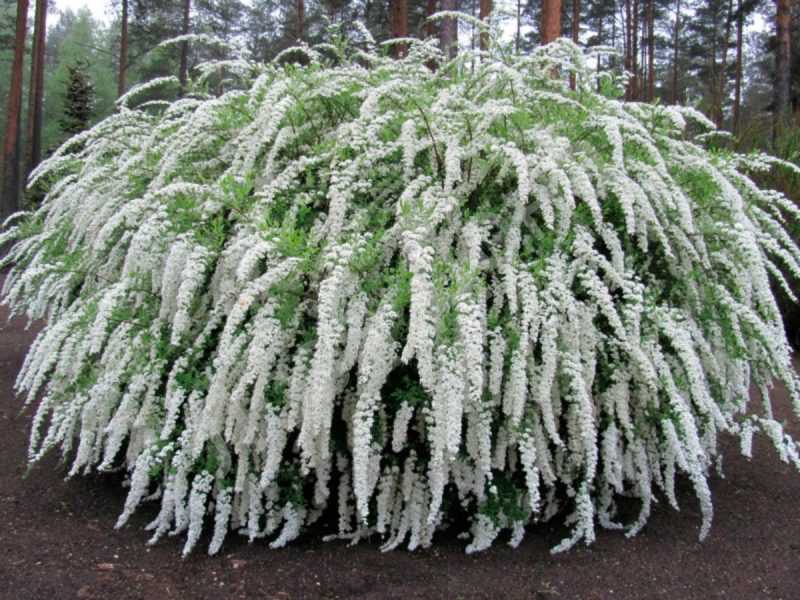
If a variety blooms in summer, it is better to plant it in spring, early flowering varieties are planted in autumn, but so that the bushes take root before the onset of frost. In both cases, the plants should be at rest. In spring, the buds should not yet swell, and in autumn, leaf fall should already end.
Outdoor Spirea Care
An unpretentious plant does not require special care measures, but timely feeding and watering will provide it with maximum decorativeness.
How to water?

Spirea is a drought-tolerant plant, but in extreme heat and with prolonged absence of rain, it needs to be watered. This is especially true for recently planted bushes. For an adult plant, the irrigation rate is 1.5 buckets per bush. For undersized species and varieties, one bucket is enough. It is enough to carry out watering once every 2 weeks, soaking the root layer well.
Fertilizer and fertilizing
In order for spirea to grow and bloom well, they should be regularly fed.
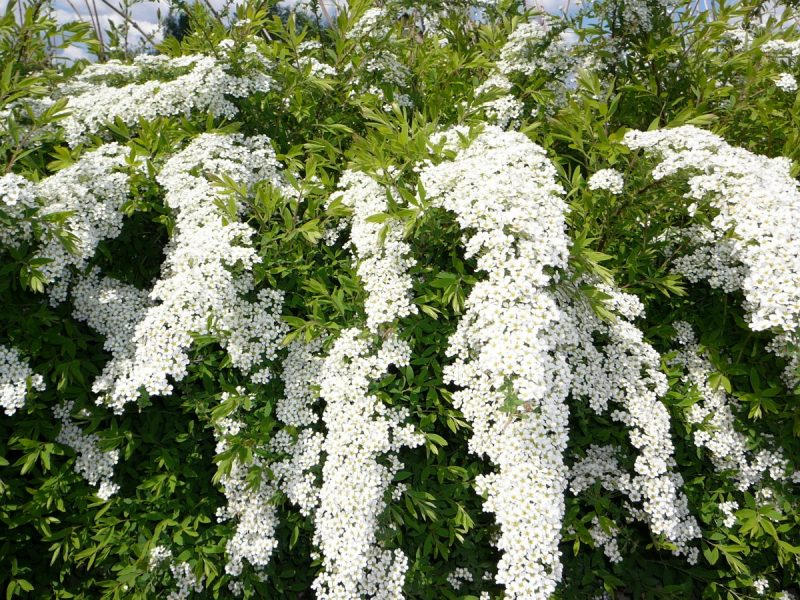
You can select the following power scheme:
- in spring, nitrogen mineral or organic fertilizer, for early-flowering varieties, additional fertilizing with full mineral fertilizer with trace elements is needed;
- in June, plants are fed with full mineral fertilizer;
- At the end of August, fertilizing with phosphorus and potassium salts is needed so that the spirea is better prepared for the winter.
At the end of summer, spirea can not be fed with any fertilizer containing nitrogen, this can trigger the growth of new shoots that do not have time to mature and freeze in winter.
All dressings can be applied both in dry and in liquid form, combining them with watering. The next day, the soil around the plant needs to be loosened.
Pruning spirea
It is carried out in several terms, depending on the destination.
- Spring pruning is sanitary. Only dry and frost-damaged shoots are removed.
- Formative. Spirea blooming in summer on the shoots of the current year are pruned in spring immediately after the snow melts, combining formative pruning with sanitary. Thin branches that thicken the bush are removed - they will not give good flowering. Different types of spirea have their own subtleties in pruning. Pruning of Douglas and Bumald spirales begins only in the fourth year of life. Miniature varieties not exceeding a height of 40 cm are cut into 2 buds. Cut shoots with foliage that does not match the color of the variety. After flowering, seed bolls are removed if there is no need for seeds - this helps to re-bloom the inflorescences. It is enough to trim a third of the shoot. The green hedge is cut to give the necessary shape. Spring-flowering spirea form after flowering, pruning shoots at the level of strong young growth. The crown of the bush should be symmetrical.
- Anti-aging pruning. It is carried out in adult bushes, starting from 7 years of age. All old shoots are removed, leaving no more than 5-7 young, while maintaining the symmetry of the bush. This pruning is best done in several stages, so as not to weaken the bush much.
Winter preparations
The first wintering in a recently planted bush is a serious test.But adult plants, despite the frost resistance of most varieties and species, also need preparation for winter. For many of them, it is enough to feed the plants in August with potash and phosphorus fertilizers, carry out water-charging irrigation after leaf fall and mulch the trumpet circle with humus.
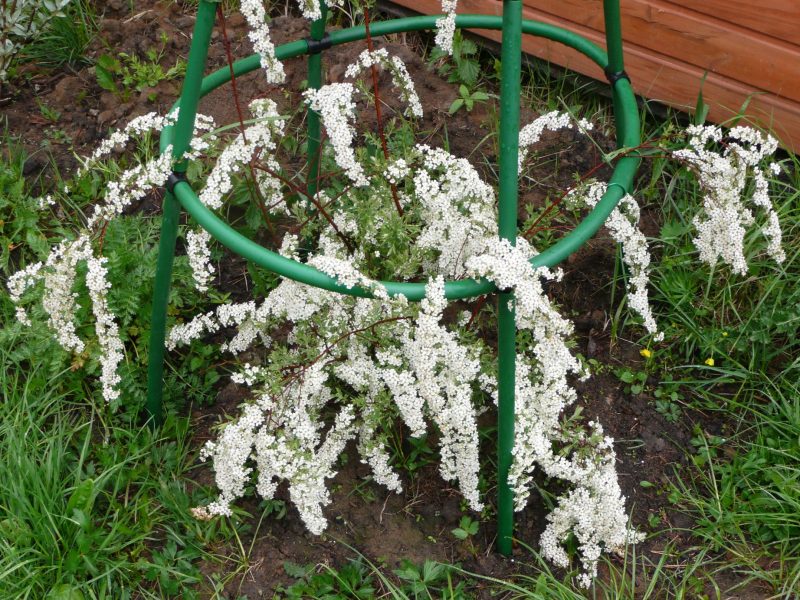
For less frost-resistant varieties, you will have to build a shelter:
- bind branches into a bundle;
- bend the beam to the ground, fixing with special fasteners;
- fall asleep with dry leaves;
- snow in addition.
Plant diseases and pests
Spirea rarely suffers from diseases, but in wet summers can be damaged by powdery mildew and gray mold. To eliminate them, use copper-containing fungicides, Fitosporin, colloidal sulfur.
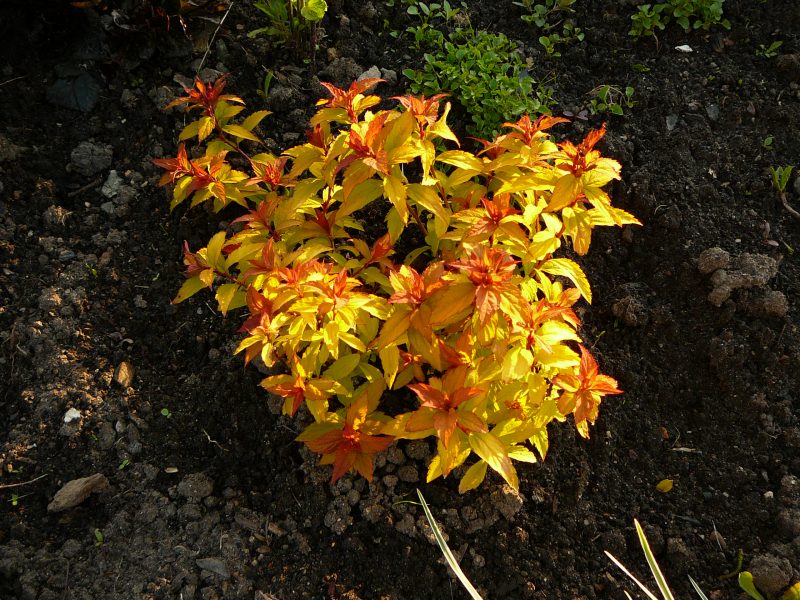
Among the most common pests are aphids, blue meadowsweet sawflies, whiteflies and spider mites. Against the first three effective insecticides: Fitoverm, Actellik. Against the tick, insect acaricides are suitable: Metaphos.
The nuances of growing in Siberia, the Urals, in the suburbs
Almost all varieties and types of spirea are suitable for cultivation in central Russia. Shrubs such as Japanese and Nippon spirea need additional winter shelter.
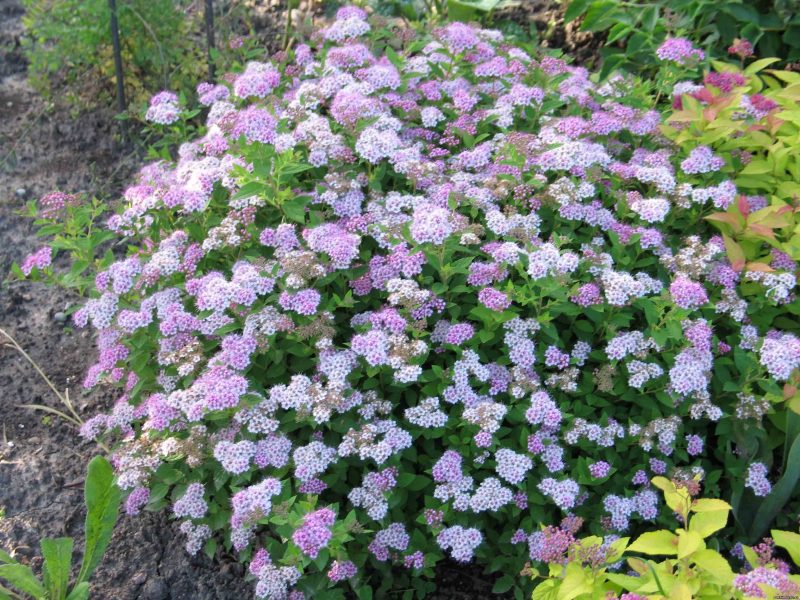
In the Urals, the climate is more severe. Almost all species of spirae will grow well in its southern part. In the middle lane and, especially in the north, frost-resistant shrubs should be preferred. The same can be said about spire in Siberia. Only undersized varieties are able to winter without much loss under snow. If medium and tall plants are not covered, then they are guaranteed constant frosting in the winter, decorativeness and abundant flowering in such conditions cannot be achieved.
Properly selected varieties of spirea are able to create a flowering conveyor throughout the growing season and will be a real decoration of any garden.












